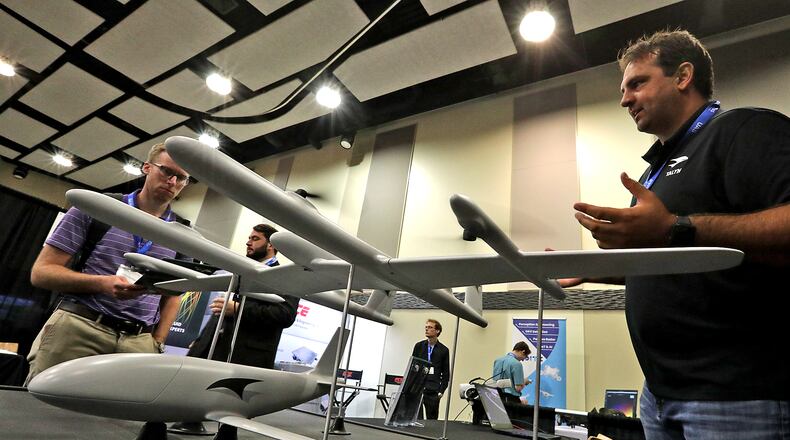The focus of the two-day event is an emerging technology — eVTOLs (electric vertical take-off and landing vehicles), air taxis or simply “flying cars.”
You can think of those vehicles as flying craft that take off in helicopter mode, fly in airplane mode then land again in helicopter mode, allowing fast travel between and within cities, advocates say.
State leaders say these vehicles herald “the third revolution in flight.”
“Ohio speaks with one voice,” said Joe Zeis, Gov. Mike DeWine’s senior adviser on aerospace and defense matters. And Zeis said that voice tells the aerospace industry: “Come (to Ohio) to test; stay to build.”
The Dayton-Springfield area has been drawing research into flying cars for a while. The 2019 opening of Skyvision at Springfield-Beckley Municipal Airport in 2019 was a key milestone, allowing Air Force Research Laboratory (AFRL) researchers to fly drones beyond a controller’s visual line of sight. The airport is just minutes away from AFRL headquarters at Wright-Patterson Air Force Base.
Another milestone: Ground will be broken Tuesday for the National Advanced Air Mobility Center of Excellence at the Springfield airport. The 30,000 square-foot, two-story building will accommodate university, business and government researchers.
It will have 25,000 square-feet in hanger space.
Credit: Bill Lackey
Credit: Bill Lackey
Col. Nathan Diller, who heads Air Force research in this arena, said the possibilities include combat search and rescue, medical evacuation, force projection and more.
“We do see this as a key, key strategic sector that we just can’t afford to lose,” Diller said at a panel discussion at Clark State Community College’s Hollenbeck Bayley Conference Center.
“We’re ready to build the flying car of the future, and it’s going to happen here,” said Jeff Hoagland, chief executive and president of the Dayton Development Coalition.
Robert Pearce, associate administrator at NASA, said NASA is increasingly looking toward zero carbon-emission vehicles that are able to fly speedily and efficiently.
“The aerospace of the future is going to look different,” Pearce said.
But it will have to be done safety, said Abigail Smith, deputy executive director for UAS integration for the Federal Aviation Administration.
In the short term, these vehicles will be piloted with human pilots, flying from existing airport and heliport infrastructure. But industry leaders already have an eye on autonomy, Smith said.
“Safety is our north star,” she said.
Recently, the Wall Street Journal reported that United Airlines put down a $10 million deposit for 100 electric four-passenger flying taxis being developed by Archer Aviation, an investment that was said to be the first real cash commitment to these vehicles.
The conference ‘s second day will begin at 8 a.m. Tuesday with flight demonstrations at Springfield-Beckley. (Registration for the event closed Friday.)
About the Author


